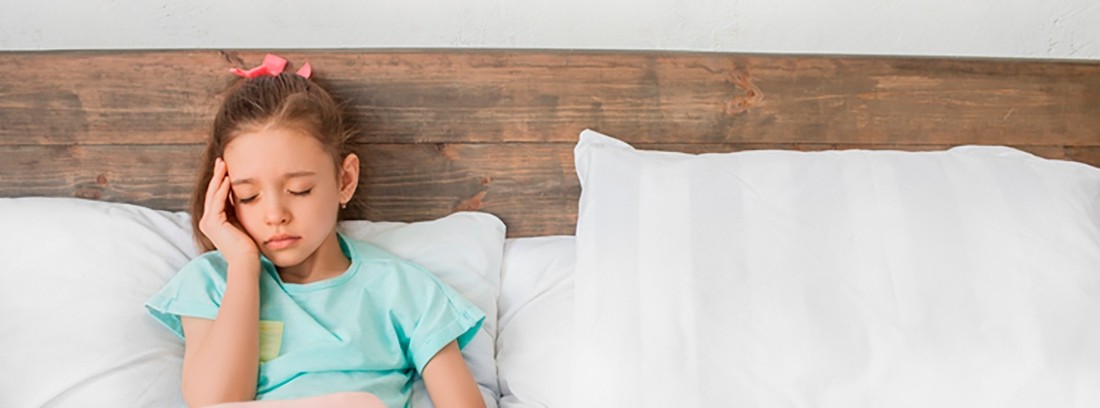Infant and infant headaches

Headaches, popularly called headaches, are all pains originated in any of the structures of the head that can cause pain: blood vessels, sinuses or muscles. Headache can appear at any age, even in babies.
Causes
Headache can have multiple origins, and in the majority of cases its cause is banal, without importance. Even so, it must be borne in mind that it may be the first disease symptom serious such as meningitis, encephalitis or brain tumors.
The headache does not originate in the brainor, but in neighboring structures, such as the cranial arteries, intracranial veins, cranial and spinal nerves, meninges, cranial and cervical muscles, paranasal sinuses, nose, teeth, skin, etc.
Types of childhood headaches
- Acute: are those caused by fever, infections: otitis, sinusitis, meningitis and head trauma.
- Subacute: such as tension headaches, migraines, tumors, or hydrocephalus.
- Chronic or recurrent: mainly due to migraine, tension headaches, vision problems, tumors, abuse of analgesics.
Symptoms
The intensity and intensity depend on the cause of the headache. Sometimes it is the main symptom and, in others, it will accompany other symptoms.
We can divide headaches into two large groups based on whether they are associated with fever or not:
- Headache and fever: Fever by itself can cause a headache and some stiffness in the neck muscles. All this disappears when the temperature drops. A serious condition such as meningitis should be suspected when the headache is accompanied by violent vomiting and persistent neck pain.
- Headache without fever: in most cases these are migraines and tension headaches. Much less often it is a tumor or hydrocephalus.
The Pediatrician makes the diagnosis through symptoms and physical examination. Only in some cases does a headache require more complex diagnostic tests such as a paranasal sinus X-ray, a CT scan or brain MRI.
And the migraine?
It is a very common cause of headaches in children. About a third have their first episode of migraine at 4-5 years. The characteristics of migraine are:
- pain that lasts between 2 hours and 3 days
- Throbbing pain like a heartbeat
- pain on one side of the head
- pain is severe and the child stops doing normal activities, such as playing or watching television
- nausea and vomiting (in some cases)
- Photophobia or light disturbances
- Sonophobia and discomfort of sounds.
- Aura (see little lights, flying flies, black stripes ...)
- Tingling somewhere in the body
They improve with sleep and rest and most often there are close relatives of the child who suffer from migraines.
migraine triggersThere are factors that can be precipitating and that trigger migraine:
- Chocolate, nuts, cheese, ice cream, preserves, spices, hot and citrus
- Prolonged fasting
- Physical exercise,
- Climatic factors
- School overload
- Emotional overload
- noises, bright lights, flashing lights
- Various drugs.
Treating migraines requires a quiet environment, with little light and little noise. Are used analgesics of various types depending on the intensity of the pain. In the most serious and often repeated cases, he may prescribe a preventive treatment.
Tension headache
It is a common cause of headache. The factors that trigger it are psychogenic, such as school and family problems that cause a state of anxiety. It is not aggravated by physical activity or waking the child at night. It usually occurs in anxious children, which describe a continuous pain located in the neck or throughout the head that is not throbbing or bothered by light or noise. Often they belly hurts and vomiting associated. Typically, the pain does not appear on the weekend or during the holidays.
It is necessary to consult the Pediatrician if:
- The headache is accompanied by vomiting and high fever.
- If accompanied by unexplained drowsiness.
- If the pain wakes the child at night.
- If vomiting occurs without previous nausea.
- If it is accompanied by changes of character, sadness, apathy or decreased school performance.
- If the child has greater clumsiness of movements, decreased vision or hearing.
- When the pain does not subside with the usual medication.
- If the pain lasts for days-weeks and does not go away.
- If your head hurts with changes in posture.
(Updated at Apr 14 / 2024)